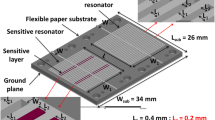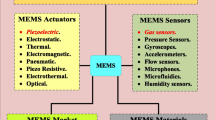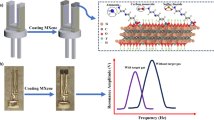Abstract
Micro-electro-mechanical systems (MEMS)-based resonators have a wide range of current applications such as the detection of chemical and biological substances. Up to now, several studies have been done in the literature about the integration of conducting polymers with MEMS to design a sensing layer for the applications mentioned above. However, all studies have been carried out on the coating of MEMS cantilever which has some disadvantages for the mass sensor like position-depended sensing as a result of being not only a mechanical spring structure but also a proof mass. In this study, conductive polymers (CPs) have been coated on different MEMS lateral comb-drive resonator designs by an effortless and effective solution provided by the electrochemical polymerization technique for the first time in the literature. An aqueous dispersion of carboxymethyl cellulose (CMC) and pyrrole has been formed, and the PPy/CMC composite film has been homogeneously coated on the MEMS resonators by electrochemical polymerization. The integration of CPs with MEMS has not only benefited the mechanical advantages of the lateral resonator but also used optical, electrical, and functional properties of the CPs. To examine its utilization as a sensor, the designed resonators have been used in the detection of volatile organic compounds in open-air conditions. Due to the differences in intermolecular interaction according to the polymer and VOCs structure, discrimination and detection of the VOCs have been performed even in uncontrolled air conditions.
Graphical abstract








Similar content being viewed by others
References
Kilinc N, Cakmak O, Kosemen A, Ermek E, Ozturk S, Yerli Y, Ozturk ZZ, Urey H (2014) Fabrication of 1D ZnO nanostructures on MEMS cantilever for VOC sensor application. Sens Actuators B Chem 202:357–364. https://doi.org/10.1016/j.snb.2014.05.078
Timurdogan E, Alaca BE, Kavakli IH, Urey H (2011) MEMS biosensor for detection of hepatitis A and C viruses in serum. Biosens Bioelectron 28:189–194. https://doi.org/10.1016/j.bios.2011.07.014
Amírola J, Rodríguez A, Castañer L, Santos JP, Gutiérrez J, Horrillo MC (2005) Micromachined silicon microcantilevers for gas sensing applications with capacitive read-out. Sens Actuators B Chem 111–112:247–253. https://doi.org/10.1016/j.snb.2005.07.053
Li C-S, Li M-H, Chin C-H, Li S-S (2013) Differentially piezoresistive sensing for CMOS-MEMS resonators. J Microelectromechan Syst 22:1361–1372. https://doi.org/10.1109/JMEMS.2013.2257689
Kalicinski S, Tilmans HAC, Wevers M, De Wolf I (2009) A new characterization method for electrostatically actuated resonant MEMS: determination of the mechanical resonance frequency, quality factor and dielectric charging. Sens Actuators A Phys 154:304–315. https://doi.org/10.1016/j.sna.2008.06.032
Somà A, Ballestra A (2009) Residual stress measurement method in MEMS microbeams using frequency shift data. J Micromech Microeng 19:095023. https://doi.org/10.1088/0960-1317/19/9/095023
Baek I-B, Byun S, Lee BK, Ryu J-H, Kim Y, Yoon YS, Jang WI, Lee S, Yu HY (2017) Attogram mass sensing based on silicon microbeam resonators. Sci Rep 7:46660. https://doi.org/10.1038/srep46660
Patocka F, Schneider M, Dörr N, Schneidhofer C, Schmid U (2019) Position-dependent mass responsivity of silicon MEMS cantilevers excited in the fundamental, two-dimensional roof tile-shaped mode. J Micromech Microeng 29:045009. https://doi.org/10.1088/1361-6439/ab062a
Ghatkesar MK, Barwich V, Braun T, Ramseyer J-P, Gerber C, Hegner M, Lang HP, Drechsler U, Despont M (2007) Higher modes of vibration increase mass sensitivity in nanomechanical microcantilevers. Nanotechnology 18:445502. https://doi.org/10.1088/0957-4484/18/44/445502
Bayraktar E, Eroglu D, Ciftlik AT, Kulah H (2011) A MEMS based gravimetric resonator for mass sensing applications. In: IEEE 24th international conference on micro electro mechanical systems, IEEE, pp 817–820. https://doi.org/10.1109/MEMSYS.2011.5734550
Eroglu D, Bayraktar E, Kulah H (2011) A laterally resonating gravimetric sensor with uniform mass sensitivity and high linearity. In: 2011 16th international solid-state sensors, actuators and microsystems conference, IEEE, pp 2255–2258. https://doi.org/10.1109/TRANSDUCERS.2011.5969332
Kangül M, Aydın E, Gökçe F, Toral T, Zorlu O, Külah H (2016) Design of a resonator-on-microchannel (RoM) for gravimetric detection applications in liquid environment. Procedia Eng 168:506–509. https://doi.org/10.1016/j.proeng.2016.11.510
Soganci T, Baygu Y, Kabay N, Gök Y, Ak M (2018) Comparative Investigation of peripheral and nonperipheral zinc phthalocyanine-based polycarbazoles in terms of optical, electrical, and sensing properties. ACS Appl Mater Interfaces 10:21654–21665. https://doi.org/10.1021/acsami.8b06206
Soganci T, Gumusay O, Soyleyici HC, Ak M (2018) Synthesis of highly branched conducting polymer architecture for electrochromic applications. Polymer 134:187–195. https://doi.org/10.1016/j.polymer.2017.11.067
Ak M, Soganci T (2019) Chapter 10. Electrochemical properties and electrochromic device applications of polycarbazole derivatives. In: Jian Wei Xu KWS, Ming Hui Chua (Ed.), Electrochromic Smart Mater. Fabr. Appl., First, The Royal Society of Chemistry 2019, London, pp 293–322. https://doi.org/10.1039/9781788016667-00293
Soganci T, Soyleyici S, Soyleyici HC, Ak M (2017) Optoelectrochromic characterization and smart windows application of bi-functional amid substituted thienyl pyrrole derivative. Polymer 118:40–48. https://doi.org/10.1016/j.polymer.2017.04.060
Guimard NK, Gomez N, Schmidt CE (2007) Conducting polymers in biomedical engineering. Prog Polym Sci 32:876–921. https://doi.org/10.1016/j.progpolymsci.2007.05.012
Hussain KK, Gurudatt NG, Akhtar MH, Seo K-D, Park D-S, Shim Y-B (2020) Nano-biosensor for the in vitro lactate detection using bi-functionalized conducting polymer/N, S-doped carbon; the effect of αCHC inhibitor on lactate level in cancer cell lines. Biosens Bioelectron 155:112094. https://doi.org/10.1016/j.bios.2020.112094
Gustafsson G, Cao Y, Treacy GM, Klavetter F, Colaneri N, Heeger AJ (1992) Flexible light-emitting diodes made from soluble conducting polymers. Nature 357:477–479. https://doi.org/10.1038/357477a0
Walker B, Kim C, Nguyen T-Q (2011) Small molecule solution-processed bulk heterojunction solar cells. Chem Mater 23:470–482. https://doi.org/10.1021/cm102189g
Soganci T, Soyleyici HC, Ak M (2016) A soluble and fluorescent new type thienylpyrrole based conjugated polymer: optical, electrical and electrochemical properties. Phys Chem Chem Phys 18:14401–14407. https://doi.org/10.1039/C6CP02214F
Turac E, Varol R, Ak M, Sahmetlioglu E, Toppare L (2008) Electrochemical synthesis of a water-soluble and self-doped polythiophene derivative. Des Monomers Polym 11:309–317. https://doi.org/10.1163/156855508X332469
Gangopadhyay R, De A (2000) Conducting polymer nanocomposites: a brief overview. Chem Mater 12:608–622. https://doi.org/10.1021/cm990537f
Ak M, Cirpan A, Yılmaz F, Yağcı Y, Toppare L (2005) Synthesis and characterization of a bifunctional amido-thiophene monomer and its copolymer with thiophene and electrochemical properties. Eur Polym J 41:967–973. https://doi.org/10.1016/j.eurpolymj.2004.11.031
Abidian MR, Kim D-H, Martin DC (2006) Conducting-polymer nanotubes for controlled drug release. Adv Mater 18:405–409. https://doi.org/10.1002/adma.200501726
Ozturk Kirbay F, Ayranci R, Ak M, Odaci Demirkol D, Timur S (2017) Rhodamine functionalized conducting polymers for dual intention: electrochemical sensing and fluorescence imaging of cells. J Mater Chem B 5:7118–7125. https://doi.org/10.1039/C7TB01716B
Hofmann AI, Östergren I, Kim Y, Fauth S, Craighero M, Yoon M-H, Lund A, Müller C (2020) All-polymer conducting fibers and 3D Prints via melt processing and templated polymerization. ACS Appl Mater Interfaces 12:8713–8721. https://doi.org/10.1021/acsami.9b20615
Ak M, Durmus A, Toppare L (2007) Solid state electrochromic device applications of N-(2-(thiophen-3-yl)methylcarbonyloxyethyl) maleimide. Solid State Sci 9:843–849. https://doi.org/10.1016/j.solidstatesciences.2007.06.016
Fu X, Wang JK, Ramírez-Pérez AC, Choong C, Lisak G (2020) Flexible conducting polymer-based cellulose substrates for on-skin applications. Mater Sci Eng C 108:110392. https://doi.org/10.1016/j.msec.2019.110392
Ayranci R, Ak M (2016) Synthesis of a novel, fluorescent, electroactive and metal ion sensitive thienylpyrrole derivate. New J Chem 40:8053–8059. https://doi.org/10.1039/C6NJ02006B
Tekbaşoğlu TY, Soganci T, Ak M, Koca A, Şener MK (2017) Enhancing biosensor properties of conducting polymers via copolymerization: synthesis of EDOT-substituted bis(2-pyridylimino)isoindolato-palladium complex and electrochemical sensing of glucose by its copolymerized film. Biosens Bioelectron 87:81–88. https://doi.org/10.1016/j.bios.2016.08.020
Göktuğ Ö, Soganci T, Ak M, Şener MK (2017) Efficient synthesis of EDOT modified ABBB-type unsymmetrical zinc phthalocyanine: optoelectrochromic and glucose sensing properties of its copolymerized film. New J Chem 41:14080–14087. https://doi.org/10.1039/C7NJ03250A
Roh E, Hwang B-U, Kim D, Kim B-Y, Lee N-E (2015) Stretchable, transparent, ultrasensitive, and patchable strain sensor for human-machine interfaces comprising a nanohybrid of carbon nanotubes and conductive elastomers. ACS Nano 9:6252–6261. https://doi.org/10.1021/acsnano.5b01613
Ghorbani Zamani F, Moulahoum H, Ak M, Odaci Demirkol D, Timur S (2019) Current trends in the development of conducting polymers-based biosensors. TrAC Trends Anal Chem 118:264–276. https://doi.org/10.1016/j.trac.2019.05.031
Ak M, Yigitsoy B, Yagci Y, Toppare L (2007) Gas sensing property of a conducting copolymer. E-Polymers 7:1–8. https://doi.org/10.1515/epoly.2007.7.1.495
Ayranci R, Demirkol DO, Timur S, Ak M (2017) Rhodamine-based conjugated polymers: potentiometric, colorimetric and voltammetric sensing of mercury ions in aqueous medium. Analyst 142:3407–3415. https://doi.org/10.1039/C7AN00606C
Ak M, Yildiz HB, Toppare L (2014) Enzyme immobilization in a photosensitive conducting polymer bearing azobenzene in the main chain. Polym Bull 71:1827–1841. https://doi.org/10.1007/s00289-014-1157-7
Ramanavicius S, Ramanavicius A (2021) Charge transfer and biocompatibility aspects in conducting polymers based enzymatic biosensors and biofuel cells. Nanomaterials 11:371. https://doi.org/10.3390/nano11020371
Ramanavicius S, Ramanavicius A (2021) Conducting polymers in the design of biosensors and biofuel cells (Review). Polymers 13:49. https://doi.org/10.3390/polym13010049
Ramanavicius S, Ramanavicius A (2020) Review insights in the application of stoichiometric and non-stoichiometric titanium oxides for the design of sensors for the determination of gases and VOCs (TiO2−x and TinO2n−1 vs. TiO2). Sensors 20:6833. https://doi.org/10.3390/s20236833
Ramanavicius S, Tereshchenko A, Karpicz R, Ratautaite V, Bubniene U, Maneikis A, Jagminas A, Ramanavicius A (2020) TiO2-x/TiO2-structure based ‘self-heated’ sensor for the determination of some reducing gases. Sensors 20:74. https://doi.org/10.3390/s20010074
Oliver Brand FJ, Dufour I, Heinrich SM (2015) Resonant MEMS: fundamentals, implementation and application, Wiley-VCH Verlag GmbH
Torunbalci MM, Tatar E, Alper SE, Akin T (2011) Comparison of two alternative silicon-on-glass microfabrication processes for MEMS inertial sensors. Procedia Eng 25:900–903. https://doi.org/10.1016/j.proeng.2011.12.221
Tez S, Aykutlu U, Torunbalci MM, Akin T (2015) A bulk-micromachined three-axis capacitive mems accelerometer on a single die. J Microelectromech Syst 24:1264–1274. https://doi.org/10.1109/JMEMS.2015.2451079
Tez S, Akin T (2012) Comparison of two alternative fabrication processes for a three-axis capacitive MEMS accelerometer. Procedia Eng 47:342–345. https://doi.org/10.1016/j.proeng.2012.09.153
Imamura G, Shiba K, Yoshikawa G, Washio T (2019) Free-hand gas identification based on transfer function ratios without gas flow control. Sci Rep 9:9768. https://doi.org/10.1038/s41598-019-46164-1
Tez S, Aytaskin E (2020) Design of a MEMS-based capacitive resonator for target analyte detection. Electrica 20:41–51. https://doi.org/10.5152/electrica.2020.19054
Sabry Y, Medhat M, Bourouina T, Khalil D (2012) Parameter extraction of MEMS comb-drive near-resonance equivalent circuit: physically-based technique for a unique solution. J Micro/Nanolith MEMS MOEMS. https://doi.org/10.1117/1.JMM.11.2.021205
Bao M, Yang H, Yin H, Shen S (2000) Effects of electrostatic forces generated by the driving signal on capacitive sensing devices. Sens Actuators A Phys 84:213–219. https://doi.org/10.1016/S0924-4247(00)00312-5
Råback P, Malinen M, Ruokolainen J, Pursula A, Zwinger T (eds) (2019) Elmer Models Manual (2022), CSC–IT Center for Science. http://www.nic.funet.fi/pub/sci/physics/elmer/doc/ElmerModelsManual.pdf
Ahrens J, Geveci B, Law C (2005) ParaView: an end-user tool for large-data visualization. In: Vis. Handb., Elsevier, pp 717–731. https://doi.org/10.1016/B978-012387582-2/50038-1
Naik S, Hikihara T (2011) Characterization of a MEMS resonator with extended hysteresis. IEICE Electron Express 8:291–298. https://doi.org/10.1587/elex.8.291
Yamane D, Matsushima T, Konishi T, Toshiyoshi H, Masu K, Machida K (2016) A dual-axis MEMS capacitive inertial sensor with high-density proof mass. Microsyst Technol 22:459–464. https://doi.org/10.1007/s00542-015-2539-y
Lee JEY, Seshia AA (2011) Direct parameter extraction in feedthrough-embedded capacitive MEMS resonators. Sens Actuators A Phys 167:237–244. https://doi.org/10.1016/j.sna.2011.02.016
Reichardt C, Welton T (2010) Solvents and solvent effects in organic chemistry, Wiley-VCH Verlag GmbH & Co. KGaA, Weinheim, Germany. https://doi.org/10.1002/9783527632220
Acknowledgements
This study is supported by the Scientific and Technological Research Council of Türkiye (TUBITAK) under the grant number 116E231. The authors would like to thank TUBITAK.
Author information
Authors and Affiliations
Corresponding authors
Additional information
Handling Edtor: Yaroslava Yingling.
Publisher's Note
Springer Nature remains neutral with regard to jurisdictional claims in published maps and institutional affiliations.
Supplementary Information
Below is the link to the electronic supplementary material.
Rights and permissions
Springer Nature or its licensor (e.g. a society or other partner) holds exclusive rights to this article under a publishing agreement with the author(s) or other rightsholder(s); author self-archiving of the accepted manuscript version of this article is solely governed by the terms of such publishing agreement and applicable law.
About this article
Cite this article
Tez, S., Ak, M. Integration of conducting polymers with MEMS lateral comb-drive resonator via electrodeposition for VOCs detection. J Mater Sci 58, 3078–3093 (2023). https://doi.org/10.1007/s10853-023-08203-1
Received:
Accepted:
Published:
Issue Date:
DOI: https://doi.org/10.1007/s10853-023-08203-1




